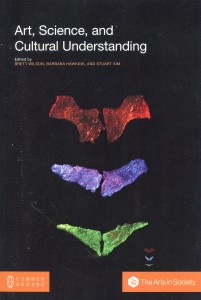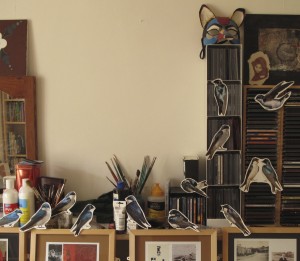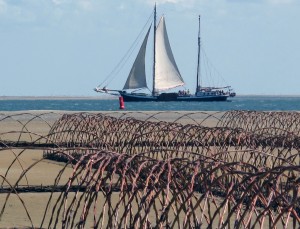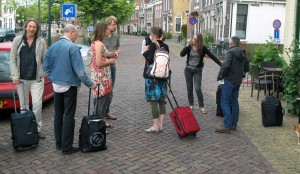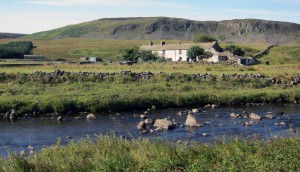
Part One. Reframing Northern Spaces: place, creative practice, and collaboration.
This piece of writing is in two parts. The first part is a slightly revised version of a paper I’ve just given at a workshop on Holy Island or Lindisfarne, just off the Northumbrian coast, for the Northern Peripheries Network which, entirely by chance (or not) can now also serve as background context for the second part. The day workshop for which this was written took place just prior to what turned out to be a wonderful two-day conference – Further North – organized by Ysanne Holt and Angela McClanahan. The second part -to follow – is a provisional set of thoughts in response to a paper by Tim Ingold, one that also draws on points made by a number of excellent papers given during the conference – in particular David Martin-Jones’ Where is Anywhere: Ideas of North, South, East and West and Chris Dorset’s re-situating the gallery farther south. Needless to say, my reflections are partial, a personal ‘mulling over’ of the impact of what I heard over two days on my own thinking.
So, what I myself said at the workshop was roughly as follows, some of which will already be familiar to readers of this blog.
Part One: Reframing Northern Spaces: place, creative practice, and collaboration
I’m going to talk out of my experience of working in the north, but also, of course, elsewhere – I’ve been working on my Debatable Lands project on the Borders for fifteen years – so as to present a particular view of collaboration. Some of you may feel this view is rather extreme but, having just been listening to younger artists and geographers at three sessions on geo-aesthetics at the Royal Geographical Society Conference in London last week, I can at least confirm that it’s not an entirely idiosyncratic one. What I want to say could be related in some detail to various academic arguments. To Matthew Fuller’s wild generalization that: “art … has oozed out and “become feral in combination with other forms of life”; to Sarah Whatmore and Catharina Landstrum’s work around ‘knowledge controversies’, ‘competency groups’, and ‘pre-figured categories’; or to Yuriko Saito’s argument that we need to pay more attention to the aesthetics of the everyday and less to the aesthetics of the exceptional. But my focus is ultimately practical – to help change views of collaboration and its framings. So I’ll start there, then indicate three points of resistance to dominant cultural framings, and end by introducing examples of a specific type of collaborative project.
Ffion Jones farms with her partner in the hills of mid Wales. She’s bringing up a young daughter, studying for a doctorate at Aberystwyth University, and making extraordinary multi-media performances. Simon Read teaches at Middlesex University, produces sculptural interventions in salt marshes, and makes beautifully drawn maps predicting future costal change so as to influence debates about managing the Suffolk coast. What Ffion and Simon do is normally identified as ‘art’ and I have no particular quarrel with that. But I do wonder increasingly if this does justice to their relationship to place ortheir ability to work collaboratively between radically different lifeworlds. Personally I think of them as being as much multi-skilled cultural translators working across a lifeworld as polyverse – a world made up of multiple and sometimes antagonistic normative positions that are usually seen as largely separate and distinct.
Recently I’ve come to understand that the work I’ve done over the last twenty odd years falls along a fairly broad spectrum – with genuine collaboration at one end and basic co-operation at the other. I’d argue that what animates this spectrum can be related to the two meanings of collaboration: “to work together, especially in a joint intellectual effort”, and “to cooperate treasonably, as with an enemy occupying one’s country”. Grant Kester refers to these two meanings at the start of The One and the Many and, conventionally, goes on to oppose them. But I think they’re actually linked at an underlying level. I think both involve challenging given roles and identities. Genuine collaboration requires that we are willing to recognize, question, and negotiate what are often uncomfortable differences between the parties involved. That process requires a type of translation across differences that changes us, or at least has the potential to do so. But radical change in a person can all too easily be taken by others as a form of betrayal – particularly by those people who can’t or – because of vested interests – won’t think beyond the polarized categories of ‘friend’/‘enemy’, ‘specialist’/‘layperson’, ‘artist’/‘public’.
So I find myself wondering whether or not the woman in Edward Capa’s ‘Collaborator woman who had a German soldier’s child, Chartres’was in fact a genuine collaborator, not just someone who simply co-operated with France’s enemies? Might it not be that her love for the child’s father led her to question the category ‘enemy’ to the point where her own self-identity was actually transformed? Whatever the case, I would argue that genuine collaboration – by putting in question the frames of reference on which our institutionalized professional identities into question – is transformative. This clearly makes genuine collaboration a risky and transformative act in any profession where conformity to a status quo predicated on disciplinary realpolitik is a tacit requirement for any ambitious person.
Of course it also means that what academic and cultural institutions call collaboration usually isn’t – it’s actually carefully regulated co-operation based on a pre-existing consensus. Necessarily so – institutionalised authority flows from maintaining or adapting existing framings and presuppositions, not from questioning them. (A point we need to remember when we identify with that authority). It may be that distinguishing collaboration from co-operation goes some way to explain institutional and Government obsession with ‘inter-disciplinarity’. While there are obviously plenty of exceptions to what I’m about to say, I think most academic research that claims to be what’s called ‘interdisciplinarity’ is in fact little more than a slight of hand. In reality the researchers involved simply share a loose co-operative framework that allows them to do precisely what they always do – work on the basis of existing, highly institutionalised, disciplinary presuppositions. Of course such projects may sometimes produce innovative outcomes, but the problem – at least as I see it – is that this leaves the underlying framings unquestioned, not to say unchallenged. Over fifteen years ago Doreen Massey quoted Barbara Bender’s observation that (I quote): “landscapes refuse to be disciplined. They make a mockery of the oppositions that we create between time [History] and space [Geography], or between nature [Science] and culture [Social Anthropology]”. However, while research funding and academic realpolitik remain dominated by disciplinary framings, we will continue to struggle to act on new understandings of place or genuinely collaborate.
So what about framings? I’ll restrict myself to my own area of concern, which is largely with rural lifeworlds. These are now increasingly subject to Government neglect of vital infrastructure, externally imposed environmental governance, and questions around energy and food security. This situation is normatively framed in various different ways. One is dismissive, locating the rural as non-place. It’s neatly summarized by Marx and Engels’ phrase: “the idiocy of rural life” and is implicit in much arts and cultural policy. A second is more complex, involving different mixes of Romanticism, regional tradition, New Age spirituality, and Edenic environmentalism. While each mix inflects the rural differently, they all idealize it over against the urban. The third framing can be characterized as ‘instrumental’. It treats the rural as ‘standing reserve’ – a resource to be exploited with no proper regard for its particular lifeworlds and ecologies. This framing is only too obvious when the Government appoints individuals embedded in the business world to head the Environment Agency and Natural England. But it also appears in a disturbing new guise in the rise of eco-scientism as a coercive top-down rhetoric in public debates about, for example, resilience.
These three normative framings regularly lock different social constituencies into mutual incomprehension, provoking protective withdrawal and making constructive exchange, let alone collaboration, very difficult. As a result different constituencies become locked into bitter, long-running conflicts – around GM crops and alternative energy in the UK, or small-scale family turf cutting in Ireland. Working across these deeply engrained normative framings requires creative, collaborative translation based on specialist knowledge, empathetic imagination, creativity, patience, and mediation skills. Simon Read and Ffion Jones are, in my view, involved both in just such creative translation. Their work facilitates multi-constituency collaboration between antagonistic constituencies and is helping develop a new, more inclusive, aesthetic.
This kind of work is certainly not without its problems. Creative translators learn many of their skills through a professional, disciplinary training. But the people they work with in rural contexts often suspect any authority based on the framings that underpin those skills. Rural selfhoods are largely dependent on another, place-specific, performative framing – one that has little time for discursive, categorical knowledge. Instead they derive identity and authority from their qualitative, embodied co-constitution in and with a specific taskscape. Addressing this difference – a primary source of conflict between professional and lay constituencies of all kinds – is a central part of Simon Read and Ffion Jones’ work to build bridges across the differences between university-trained professionals and rural workers.
As my quotation from Barbara Bender indicates, this work requires that we don’t over-identify with disciplinary positions. Instead we have to recognize, with Geraldine Finn, that we are always both more and less than the categories that name and divide us. In reality we each live in a polyverse where our various persona – professional, lay, amateur, or domestic – require collaboration on a daily basis. However, all professional work is now increasingly framed so as to reward those who internalize the values of the institutions that validate them as discrete ‘worlds-unto-themselves’. This situation prevents genuine collaboration, ensuring that the deep-seated framings that underwrite our current environmental and psychosocial difficulties go largely unchallenged.
So how do we address the tension between skills learned in a lifeworld as polyverse and those delivered by professional ‘worlds-unto-themselves’. I’ll suggest some possible answers in two stages. First, I’ll indicate three attitudes to place that help resist disciplinary professional framings. These aren’t concerned with place in terms of an aesthetic of the exceptional that speaks primarily to the eye, but with our constantly re-placed ourselves – physically, psychosocially, and ecologically – in ways that value an aesthetic of the everyday. I’ll then very briefly introduce some collaborative projects that I take to be genuinely transformative.
The first form of resistance I want to stress is ‘slowness’ in relation to place and collaboration. Christine Baeumler, working with an ecologist and an engineer, set up this tamarack wetland restoration project on the roof of the main entrance to the Minneapolis College of Art and Design.It took years to raise funds, plan, and negotiate this demonstration that, even when transposed into an urban environment, such a fragile ecosystem could, given the right conditions, serve both as green roof infrastructure and an aesthetic micro-environment. As I understand it, Christine’s praxis has, over many years,gradually ‘gone feral’. To art students at the University of Minnesota she’s an inspiring and dedicated teacher. To her employer she’s an effective faculty member with an exemplary research and public engagement record. To local ethnic minority communities she’s a facilitator for environmental youth programmes. To her arts peers she’s a respected artist working across a multitude of media – including painting, installation, film and ecologically led landscape design. To local Dakota community activists she is a long-term practical ally in their fight for cultural recognition and proper representation. Finally, and centrally, to her neighbours Christine is somebody who has worked for eighteen years on community projects restoring the everyday environmental where she lives. It’s this slow engagement with the place in which she lives that’s catalyzed the transformation of her practice, both operationally and aesthetically. This relates directly to Whatmore and Landstrum’s discussion of the need (I quote): “to ‘slow down’ expert reasoning and so create opportunities to generate new knowledge opportunities and gather new publics”.
My second area of resistance concerns acknowledging the fragility of actually enacted community and sensing the interplay of presence & absence.Marlene Creates’ Sleeping Places, Newfoundland documents the impression left where she’s just slept – a transitory imprint from each of twenty-five nights’ brief habitation. The work plays up the relationship between bodily presence, transience, and absence. She later extended this to the fragile, temporal nature of human habitation.Places of Presence: Newfoundland kin and ancestral land, Newfoundland documents just that – familial sites where a sense of community relates as much to the dynamic of natural erasure as human inhabitation. Remembering that fragility helps us guard against institutional appeals to abstract categories like ‘the academic community’, ‘the research community’, or ‘the art community’ – appeals usually intended to evoke a spurious consensus in the interests of those with most to gain. This remembrance is vital because genuine collaboration is constructively combative – energized by differences – not the result of assumed or imposed consensus determined ‘from above’.
My third type of resistance is created by a community of active skill sharing – one that create a new, usually temporary, constellation of skills.Many of you will be familiar with Place of OriginKemnay, Aberdeenshire, Scotland (1996 – 2006). This was a many faceted ten-year ‘landscape as art’ project far too rich to detail here. I simply want to remind you that it involved many very different skills –negotiating, engineering, sculpting, landscape design, community discussion – that took as a focus the history of granite quarrying in the North East of Scotland and an understanding of place as inseparable from time and change. The project came about because Kemnay grew up as a result of its quarry but was fast becoming a commuter dormitory village for Aberdeen. In addition to creating of a temporary community of act, this project parallels, albeit in a very different register, both the need for slowness exemplified by Chris Baeumler’s work and the awareness of fragility, of the play of presence and absence, in that of Marlene Creates.
I now want to introduce some projects and approaches that are located on the cusp between art and art-based aesthetics, understood as the product of a monolithic ‘world-unto-itself’ and an unbounded creativity arising from the lifeworld as polyverses and engaged in opening up a sense of the everyday and unexceptional as potentially rich in aesthetic possibility.
Pauline O’Connell works to challenge normative attitudes to community and land ownership in rural Ireland. Building on her 2012 Drawing The Water commission, she’s been working on an open-ended project, two parts of which – Heave-Ho, An Invitation To Community and Heave-Ho, Pub Pulling League – are complete. This ongoing project raises and explores issues of community and social identity by drawing on history and trace memories – in this case relating to the 1970’s Kilkenny Tug O’ War team’s experience of getting to the All Ireland Final in 1971.Pauline’s use of a community-owned field – rare in Ireland – as a site in which to invite the performance of memory, has enabled her to intervene in the ecology of her local community. Community here is seen not as a given and permanent entity – as the guarantor of established ‘positions’ – but rather as an experimental exploration undertaken by individuals coming together – however temporarily – to re-place themselves so as to face the demands of a changing culture.
Simon Read lives on a barge on the River Deben and works as an artist, teacher, environmental designer, community activist, and ecological coastal expert. He’s been involved in saltmarsh projects since 1997 and his large map drawings relate to management strategies for fluid and shifting environments, delineating specific locations and actively meditating on change. He retrieves, cross-references, and synthesizes material from many different official sources so as to be properly equipped to contribute to complex planning and governance debates around costal environment issues. Recently Simon worked on a stabilization project for the Falkenham saltmarsh that led to him designing and building biodegradable sculptural barriers to prevent erosion by managing tidal flow and encourage the controlled deposition of silt. He has worked with official agencies, the regional community and inmates from the local prison to engage with the social dimensions of environmental issues through collaboration. This includes the planning and governance process, advocating and contributing nuanced practical solutions to problems on the ground, and addressing the cultural implications and dimensions of changing understandings of land, ownership, responsibility and belonging. His work also exemplifies a move to address the aesthetic issues Yuriko Saito raises in relation to ‘un-scenic’ saltmarsh and the need to address issues of cultural sustainability.
Cathy Fitzgeraldtrained as a biologist and now works as a forester, artist filmmaker, blogger, green political activist, writer and doctoral researcher. She lives in a small wood in County Wicklowin Ireland and her many concerns radiate out from her commitment to this one place. The immediate context for Cathy’s transforming of a Sitka spruce plantation into a sustainably managed mixed species wood is the tension between piecemeal official policy and grass roots public interest in sustainable forest and broadleaf native trees. While her commitment to this transformation is regularly assessed by the Irish Council for Forest Research and Development, Cathy is also building multiple face-to-face and virtual links between the Council, silvicultural specialists, local communities, timber users, artists, and environmental enthusiasts. Her intension is to further eco-cultural, scientific, aesthetic, economic, and green policy concerns – locality, across Ireland, and internationally. Cathy’s activities are variously ecological, creative, political, and educational in their addressing the everyday aesthetics of woodlands. They interweave personal interaction and strategic use of social media to generate professional and lay understandings shared with multiple constituencies and intended to encourage exchange between them. It is her public self-education as a forester that creatively meshes together innovative forestry practice, creative work, new conceptions of organic/mechanical relationship, and fundamental issues of community and environment.
Antony Lyons trained as an environmental geo-scientist, sculptor, and landscape designer, and is concerned with tidal, estuary, watershed and other watery environments. His Lovely Weather project in Donegal took a multi-constituency approach involving scientific specialists, a local postman and dedicated folk meteorologist, and the teachers and pupils from a local school.It created dialogue between scientific weather measurements (rainfall, humidity, temperature, pressure, wind speed, wind direction), traditional local weather lore, and personal weather-related material from Antony and members of a small volunteer observation team. Local peat bogs and their role as carbon sinks became a focus during the project and a peat stack and related artworks in the final exhibition raise questions about the complexity of climate and its changes in a local context. The project – sponsored by Leonardo and Donegal County Council – brought the concerns of a number of different regional, national and international constituencies into dialogue.
I’ll start to wind this up by pointing to same other, emergent, forms of translation. The boundary between site-specific performance and religious ritual has always been permeable. As the dogmas of the Religions of the Book are increasingly co-opted by fundamentalists, it’s perhaps inevitable that ritual as a form of collaborative spiritual resistance is taken up in the arts. Some people find that art practice constitutes a training of attention that aligns them with the dynamic psychophysical aspects of traditional rituals and want to reconfigure these in contemporary terms. This type of work is often focused by the need – particularly in rural contexts – to address the erosion of traditional cycles of ritual that, paradoxically, both helped constitute rural locations as communities but also bound them to social framings that then left them marginalized and neglected by the modern world.
Lucy Wright recently coordinated Making Traditions, an event at the People’s History Museum in Manchester. She works as an ethnomusicologist, with a folk group, as a maker and, having just gained a doctorate, as a Research Associate helping small companies with product design.Notionally ‘an exhibition’ to make the completion of her doctorate, this event was in reality a unique multimedia and multi-cultural event. It showcased costume and hats produced by Lucy in collaboration with makers from different ethnic communities, together with collections of contemporary folk objects. All these served as a backdrop for an event that brought together people engaged in different forms of vernacular performance from a wide cross-section of ages, backgrounds, and folk traditions. Lucy’s own work is focused by translation between several generic lifeworlds, exploring the vernacular North East from the inside out. As folk musician, apprentice maker, and professional ethno-musicologist she has explored the boundaries between professional and vernacular worlds so as to set up new modes of translation between them that also facilitate innovative aesthetic exchanges.
In various ways and particular places, I think each of the collaborative projects I’ve introduced challenges our given framings – not by abandoning Art and its aesthetic of the exceptional but by a way of working – but more by incorporating it into what we might call creative multi-tasking – an approach that also includes the development of a more inclusive and dynamic sense of the aesthetic of everyday place. All of which, I want to suggest, flows from engaging with the lifeworld as polyverse rather than orienting one self according to a single professional world-unto-itself.
I’m very well aware that an art historian like Clare Bishop might want simply to reincorporate these projects into the usual analytical, hyper-professionalised discourse of contemporary art history – through a set of comparative judgements about their aesthetic and relational originality. However, I don’t find that helpful and have instead tried to indicate another way we might understand them – as evidence of a shift from Art as a ‘world-unto-itself), whether badged as relational or otherwise, to a form of creative ecosophical translation. I think it’s more productive to see them as invitations in this respect, to recognise the value of collaborations that challenge normative frames and, in so doing, become transformative – allowing us to genuinely re-negotiate place in terms of multiple constituencies, framings, and possibilities. Of course those people whose work I’ve referenced have also been transformed by their collaborations. They are, viewed conventionally, somehow both more and less than artists in the usual sense and so can adopt more porous and eco-socially productive positions. Positions that, in turn, might serve as models to help re-frame debates about the places we refer to as the North.
